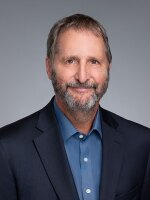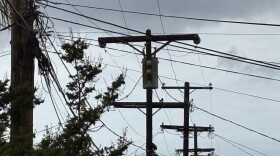It’s late morning on a Residents Free Tuesday in Balboa Park when museums offer free admission and families flock to the park. In the parking lots, cars drive in circles hoping to spy that one parking place that everyone else has missed.
“Residents Tuesday is insane!” said San Diego mom My Ly, whose two little boys laugh as they dash around the fountain in front of the Reuben H. Fleet Science Center. “Everybody wants to come to Balboa Park because it’s the place to be. It took us about 30 minutes to find parking.”
Parking is crazy just about any time you try to drive to Balboa Park on a weekend, or on days when special events occur. December nights? Don’t get park-goer Amanda Zauss started.
“I haven’t gone for the past couple of years because last time I had to park at the stadium downtown and take a tram,” Zauss said. “And it’s just really difficult with the stroller and kids.”
Arguably, the two biggest questions facing Balboa Park in the 21st century are how to maintain the park’s infrastructure and how to make it easier to get in and out of the place. The park has no trolley station. There’s a new rapid bus line along Park Boulevard, but people who take it will tell you it’s not very rapid.

The people who run the park are as frustrated as visitors. Peter Comiskey is executive director of the Balboa Park Cultural Partnership, an alliance of the park’s many institutions.
“Ever since I’ve been in Balboa Park there are periods when parking is an exceptional problem,” Comiskey said. “When people are coming to the park they need to know how to get here, how to park, and where they go within the park. All of those three things are challenging right now.”
Thomas Herrera-Mishler is CEO of the nonprofit Balboa Park Conservancy, which is dedicated to making the park financially sustainable.
“I think there’s a desperation among some people to address the parking issue here. There’s a sense of urgency because (for the cultural institutions) anytime someone can’t find a parking spot, can’t come through their doors, they’re losing money,” Herrera-Mishler said. “There’s no cultural institution in America that can afford to turn away customers right now.”
In a deeper sense, the park’s dilemma is finding the right balance between space for cars and space for people. Three years ago, the San Diego City Council confronted that issue head on. They approved a $45 million plan to remove all parking and car traffic from the Plaza de Panama, at the heart of the park, and create an 800-space underground parking structure just south of the organ pavilion.
The parking structure was not a new idea. It was part of a master plan for the park, dating back to 1989.

The money would come through a city partnership with wealthy philanthropist Irwin Jacobs. But the Plaza de Panama plan was controversial from the start among historic preservationists, who believed a traffic bypass off the Cabrillo Bridge, on the west end of the park, would be an eyesore on a beautiful historic landscape.
In 2013, a district court judge ruled the plan was illegal but that decision was overruled this year on appeal. So far, there is no indication Jacobs wants to reenter the fray, and he couldn’t be reached for comment for this story.
Nobody I spoke with disputes that public transit should be part of the solution.
But Alan Hoffman, a planning advisor and adjunct professor at San Diego State, said because Balboa Park’s users are so often families with kids, cars are a very practical means to getting people to the park.
“To be honest, people should be driving to the park because — like when we did a study for the zoo — we found the average automobile occupancy was nearly three-and-a-half people per car, which means this is the most efficient parking, probably, in the entire city," Hoffman said.
Hoffman walked with me across Balboa Park’s desert garden, and pointed across Florida Canyon to a bare expanse of land that used to be a landfill. That, he thinks, would be an ideal place for a very large peripheral parking lot for park visitors.
“That’s a great place to put parking, only because there are such limited things you can do with the land,” Hoffman said. “So you have a large resource where you could locate parking that would actually be easy to and from.”
In Hoffman’s vision, the getting-to-and-from would be done over a bridge, spanning Florida Canyon — not unlike the Cabrillo Bridge — that would accommodate walking and biking, and transport people on driverless trolleys that run on a cable loop.
How much would that bridge cost?
“I have no clue!” Hoffman said, cheerfully.
The problem of parking in Balboa Park begins when the park’s thousand-plus employees come to work.
“We get here between 8 and 9 a.m., we fill up about 550 spaces,” Herrera-Mishler said. “The problem with that is that’s the equivalent of 4,000 visitors to the park.”
Herrera-Mishler said that’s because visitors stay for a few hours, leave and someone else take their parking space. There’s no such turnover when it comes to park employees, who stick around all day.
“And those cars with visitors tend to come with more people in them. The people who come here for work… we come one per car, like most Californians do.”
There is at least one project in motion that will make a dent in the parking dilemma.
The San Diego Zoo is building a 650-space structure for their employees. It’s now going up near the back of the Old Globe Theatre. Those who want to promote shared parking wonder if Old Globe patrons might use the structure at night, when most employees have left. The zoo won’t comment.

Ultimately, the solution to the park’s access problems may not be more parking spaces but a better plan for guiding park users to places where they know they can put their cars on a busy day. Balboa Park has many parking lots, and it’s very unusual for all of them to be entirely full.
“One of the best identifiers about the Plaza de Panama plan is people will come across one significant parking reserve,” Comiskey said. “Then if that’s full they will be migrating naturally to a second, and then to a third. You won’t just be rotating around a car park that won’t have a parking space anytime soon.”
Jim Kalleberg and his wife Chris were at Balboa Park on a Residents Free Tuesday. A man with a jovial manner, Jim said the lots in the center of the park were jammed, but they found a spot near the old naval hospital where they waited for a tram.
“But by that point there were so many young families and we thought, you know, they should be on the tram with their kids and we can walk,” he said smiling. “So we did!”
Yogi Berra once said nobody goes to the ballpark anymore. It’s too crowded. The crowds may not be chasing people away from Balboa Park just yet, but keeping it a golden experience might mean doing a better job of showing people where to park their cars.







